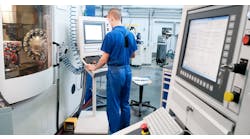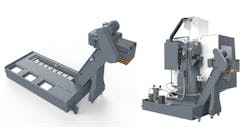The shortage of CNC machinists is among the most concerning talent problems facing the manufacturing sector. Machine shops and manufacturers of all sizes must do all they can to boost their operators’ efficiency, as well as improve hiring strategies and retention efforts. That may seem daunting, but it’s possible once you consider a few less conventional strategies.
Overcoming the machinist shortage starts with forming an effective plan. Most important, manufacturers should acknowledge that the current gap is unlikely to go away on its own.
The manufacturing sector has weathered previous labor challenges. However, the present one is nearly three times as large as those in effect 10 years ago, and much of this is due to the wavering working population. Consequently, a significant portion of today’s workforce is ageing, without enough young workers to replace them.
Future demand for CNC machining will make the impact of such a gap all the more substantial. For example, a rising need for medical devices and telecom equipment will drive 7.2% compound annual growth in the CNC machining industry over the next few years. As it does, production must scale to meet demand, which will be increasingly difficult without a large enough workforce.
Strategies to overcome the shortage
In response to the shortage, businesses may have to find creative solutions. These are some strategies worth considering.
1. Embrace automation. The most straightforward answer is to transition to automated CNC mills. Robotic cutting tools carry higher upfront costs than their conventional counterparts. Nonetheless, the resulting efficiency improvements are hard to overlook.
Note that although automation may stir up fears of job losses, the manufacturing industry must fill 1.5 million openings by 2035. Given low employment growth in the sector, it’s unlikely that businesses will be able to do so by training enough workers to perform their jobs with manual capabilities. In situations like this, robots don’t take jobs; they perform tasks that otherwise are not completed because there are not enough employees ready or available.
Robotic CNC machine set-ups promote higher output, with greater efficiency and fewer defects. The savings, in turn, should offset the initial expenses of the device and make it easier for manufacturers to scale to meet rising demands despite a smaller workforce.
2. Use semi-automated solutions. A distinct way to address the machinist shortage is to automate portions of the process. Semi-automated solutions require human involvement but take over the repetitive or error-prone tasks. As a result, a smaller workforce can accomplish more but don’t carry the same cost or job displacement fears.
Five-axis CNC machines are a good example. Both indexed and continuous 5-axis solutions do not require manual rotation of the workpiece. They also don't need constant supervision. As a result, a single employee can manage multiple mills. Productivity will rise with less dependence on additional staff.
Alternatively, organizations could automate machining-adjacent workflows, such as material handling or surface finishing. This could allow the selection of less complex and expensive robots while reducing employees’ workloads, for higher efficiency.
3. Streamline CNC programming. Similarly, optimizing the workflows around CNC machining can produce meaningful results in the manufacturing process. One way to do this would be to use a less involved CNC programming: Programming is just part of the overall workload, but it’s time-consuming and error-prone.
Conversational programming software does not use code, making it easy to learn and less likely to produce mistakes. Consequently, it’s an ideal option for manufacturers with fewer experienced workers. Employees use plug-and-play graphical interfaces to set up a machining path. This lets them complete tasks quickly and confidently without months of training.
Computer-aided manufacturing (CAM) software requires some coding. However, it can be used to automate the most complex problem-solving steps – meaning it is a middle ground between precision and usability. Manufacturers can choose between these methods by comparing the complexity of their machining workflows and the technical skills of their workforce.
4. Bring technology into recruitment. AI models can sift through applications or passive applicants’ profiles on job boards to find ideal candidates. Such tools then highlight or contact the potential applicants to streamline the recruitment process. This helps ensure new hires match the jobs they take. It may seem futuristic, but several manufacturers have reported impressive results from this technology. Siemens uses AI to filter over three million applications a year, to optimize hiring.
If you consider using AI for hiring, note that a business must acknowledge the potential for significant bias and concerns regarding dehumanization. Consequently, AI can only assist human recruiters, not replace them. Managers can implement it to minimize paperwork, but HR professionals must conduct interviews and have the final say.
5. Rethink training. Training is another important area to address. Some organizations may miss opportunities to fill positions by overlooking candidates who lack experience but have the right soft skills. Investing in on-the-job training could make it easier to grow the workforce.
When manufacturers can equip workers with the knowledge and experience of CNC operators, they can accept a wider range of applicants. Again, technology is the solution. There are a variety of tools that apply here including augmented reality (AR), virtual reality (VR) and gamified computer-based learning. These technologies make training more engaging while reducing involvement from veteran employees. As a result, on-the-job learning becomes both faster and more effective.
Manufacturers may use similar tools for broader career development opportunities. Giving workers the option to gain new skills may reduce turnover, and this could make it easier to adapt to changing needs amid rapid digitization.
Address it now
The CNC machinist shortage will not pass without some focused efforts to address it. Machine shops and other manufacturers must actively consider how to tackle it in order to move past current obstacles – and to remain productive.
These five strategies are a useful starting point for any manufacturer looking to boost output amid hiring challenges. Combining multiple methods may yield the best results. No matter how a business goes about it though, adaptation and tech adoption are crucial to overcome today’s workforce struggles.
Emily Newton is the Editor-in-Chief of Revolutionized, an online magazine exploring the latest industrial innovations.






